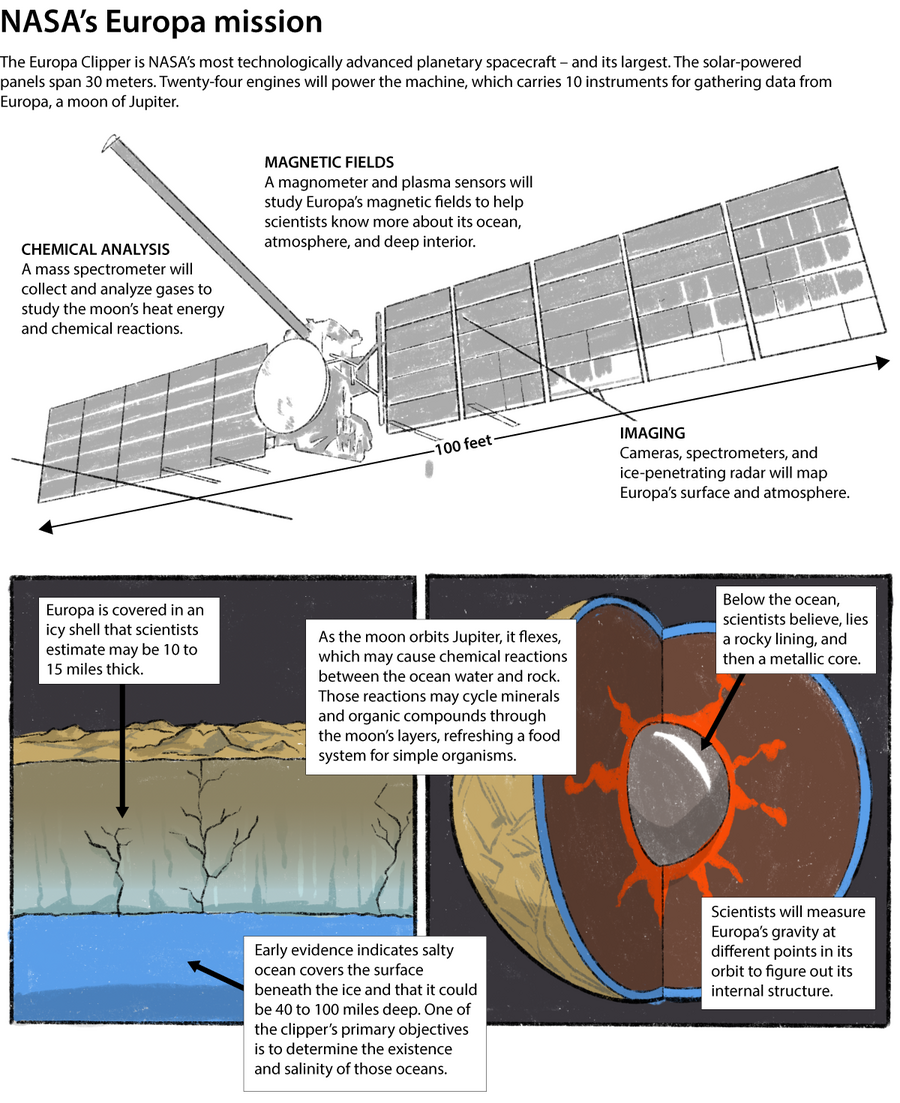Could life exist elsewhere in the universe?
Scientists are a step closer to discovering whether earthlings are alone in the universe as NASA’s most technologically advanced planetary spacecraft, the Europa Clipper, launched on Oct. 14 to head out on a 5 ½-year voyage to Europa, one of Jupiter’s 95-plus moons.
Why We Wrote This
A story focused on
The launch of the Europa Clipper mission to a potentially habitable celestial body – a moon of Jupiter – is a leap forward in the quest to answer one of humanity’s greatest questions: Is there life beyond Earth?
NASA planetary geologist Erin Leonard is part of a scientific team that will be analyzing Europa’s icy crust and underlying oceans to find out if that celestial body holds the conditions for life as we know it here on Earth. In a Monitor Q&A session, Dr. Leonard explains that Europa’s salty water and bedrock create a kind of chemistry similar to Earth’s and will be a good indicator for habitability.
She says one of the most exciting things about the mission for her is contemplating “questions that we don’t even know to ask yet.”
She adds: “There’s also this larger philosophical question of whether we understand life at all. Does life have to originate in a way that it originated on Earth?”
Could life exist elsewhere in the universe?
Scientists are one step closer to discovering whether earthlings are alone in the universe, as NASA’s largest and most technologically advanced planetary spacecraft, the Europa Clipper, launched on Oct 14. The Clipper will head for Europa, one of Jupiter’s 95-plus moons, to find out if that celestial body holds the conditions for life as we know it here on Earth.
The Clipper is 10 years in the making, and will take 5 ½ years more to get to Europa. Over the course of 49 flybys that will take 3 ½ years, the Clipper will send back data allowing scientists to examine Europa’s oceans, rock, and atmosphere. Scientists believe the oceans, in particular, are similar to Earth’s and will be a good indicator for the possibility of life there.
Why We Wrote This
A story focused on
The launch of the Europa Clipper mission to a potentially habitable celestial body – a moon of Jupiter – is a leap forward in the quest to answer one of humanity’s greatest questions: Is there life beyond Earth?
Erin Leonard has been part of the Clipper mission since its inception. The planetary geologist and Clipper project staff scientist talked with the Monitor about the mission’s science and goals, and what it all means for humanity.
The discussion has been edited for clarity and length.
What exactly are you looking for? What will indicate conditions for life?
There’s this question of whether you have some sort of nutrient cycling on Europa that might be able to sustain life.
The simplest way I explain it is: water plus rock plus energy plus time. We have water, which we think is like our ocean water on Earth. We think there’s a rocky interior – Europa’s core – that’s in contact with that subsurface ocean. That water-rock interaction is what’s producing that chemistry that you need for life potentially. That’s how we think life originated on Earth; at these mid-ocean ridges on Earth where you had the ocean water in contact with rock, in contact with heat and magma coming out of Earth’s interior.
The energy for Europa is generated through its slightly elliptical orbit around Jupiter. It causes Europa to almost breathe or flex, and that flexing generates a lot of heat in the rocky interior and then it has to come out. We think this has all been simmering together for 4 billion years. And we don’t know how long it takes for life to originate. It could be instantaneous. It could be a billion years. That’s why it’s important that we have that time component.
What are the questions about habitability?
A lot of that is about the stability and the composition of the ocean. We think it’s salty. We don’t know exactly what salts are in there or are there organics in there also. That’s a really important chemical piece for habitability. If you think about it, life might be able to originate, and then it eats everything. And if those nutrients aren’t refreshed it’s going to die. And so there has to be a cycle, a nutrient cycle also within Europa. And we think that may come from the young surface.
Europa’s surface is so young, about 100 million years old. Earth’s surface is about 200 to 300 million years old. We think that there could be some essence of plate tectonics going on in [Europa’s] icy shell that’s refreshing the surface. Oxidants in the harsh radiation environment actually produce oxidants on the surface that can then be transported in the ice shell and then into the ocean. That may provide this nutrient conveyor belt, if you will, to help refresh nutrients in the ocean that may sustain life.
What does that mean to us on Earth if life can exist on other planets, other moons?
It’s such an amazing, big question: Are we alone? And I think it’s amazing from both a fundamental humanity perspective and also from a very scientific perspective. We have one data point for life in the universe. We don’t know if we’re special and unique or if we are more common than we thought.
If we deem Europa habitable, we need to go and understand whether it’s actually inhabited, right? And there’s important implications. If it’s inhabited, maybe we understand how life originates and maybe we’re not alone in the universe. And maybe life is really common. And that would blow my mind, right? And if it’s not inhabited but we deem it to be habitable, then maybe we’re missing something. Maybe we don’t know how life really originated on Earth. We’re missing some piece to the puzzle. And it’s really hard when you only have this one data point of Earth to understand how life originates, where life might originate, and therefore whether we’re alone in our solar system or alone in the universe.
There’s also this larger philosophical question of whether we understand life at all. Does life have to originate in a way that it originated on Earth?
What are you most looking forward to discovering?
I’m excited for the answers to the questions that we don’t even know to ask yet. We think we know some stuff about Europa. But we’re going to learn so much and discover so many things with this very capable and amazing spacecraft that I don’t even know what those questions are yet.
This is a generational mission. Not only do we do it for ourselves, but we do it for the next generation. I use Voyager 2 and Galileo data still, data that’s coming up on 50 years old and 20 years old. Not only do we do missions like this for our own scientific curiosity, but also to produce these datasets that are going to last for generations to come. And that is also just so cool to think about. It’s an exciting responsibility. It’s also a big responsibility to make sure that you’re producing these datasets that are going to be valuable for generations to come.























+ There are no comments
Add yours